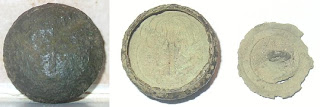Hey everyone! Sorry for the delay in posting the detecting report from Friday's trip to Bentonville. I've been too busy having fun at the Saxapahaw Holiday Market down at the Haw River Ballroom! I'll have more to say about the event in my next blog post, but it's a real pleasure showing off my finds and seeing the excellent local vendors here. I'm blogging from the ballroom as we speak, so come on over and say hi!
Friday's trip was a lot of fun. I went out with three of my friends, including Jim from Silent Remnants. We went to a couple of different promising spots, but the most productive turned out to be the same field we detected last time we were down there. In addition to Civil War era finds, it also yielded the post was coin shown below. It's an 1876 Indian Head penny, one of the lower mintage coins in that series with just under 8M produced.
I ended up with four and a quarter bullets for the day. Two of them have been very heavily chewed, one beyond recognition. I can tell that the other one is a Williams cleaner type 3. Many people claim that the term "to bite the bullet" refers to literally chewing bullets during a field amputation to manage the pain, but this is likely not the case (or was used very rarely). The origin of the term is still debated, however most accounts of field surgery refer to a thick leather strap being used, which seems a much more practical tool. Why do we find these chewed bullets them? Many animals, including cows, rodents, and especially pigs have been known to chew on lead, and likely account for most of the chewed civil war bullets recovered.
I recovered two interesting bullets today The first of these is this "carved" bullet, cut into quarters by a soldier. Soldiers used a large number of activities to pass the time in camp, and the soft lead bullets provided an excellent medium for whittling. They sometimes carved small figures of lead, and often crafted pieces for games such as chess. Silent Remnants just posted an excellent picture of a carved bullet chess piece recovered in Virginia. It's impossible to know exactly what the purpose of this cut bullet is. Even still, it provides a more personal connection than a typical dropped bullet, having been shaped by an individuals hands nearly 150 years ago. The other odd bullet I recovered is a flat based 50 caliber no-ring Minie ball, but I haven't been able to identify the exact type of bullet yet. It does show some damage to it, and I suspect that this may also be a heavily carved bullet.
The find of the day was a heavily corroded South Carolina state seal uniform coat button. The back fell apart when the packed sand was removed, but has a "Scovill MFG Co. Waterbury" raised-mark/depressed-channel backmark. The front is so heavily corroded that it's nearly impossible to see the device (front image), however the state seal of South Carolina can be seen clearly in the impression from inside the button. Despite the condition, it is still a very nice find, and I'm blessed to have dug my fourth different Confederate button in as many months.
Thanks so much for looking, and I hope you enjoyed reading! Head down to the Saxapahaw Holiday Market today if you get a chance, and look for my pictures and reflections on the event in the next few days!





No comments:
Post a Comment